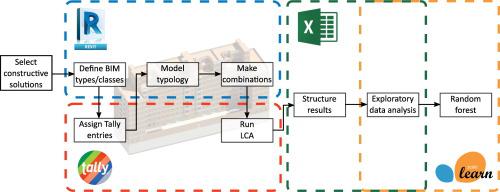Automation in Construction ( IF 10.3 ) Pub Date : 2021-10-01 , DOI: 10.1016/j.autcon.2021.103980 Alejandro Martínez-Rocamora 1 , Carlos Rivera-Gómez 2 , Carmen Galán-Marín 2 , Madelyn Marrero 1

|
Integrated life-cycle assessment (LCA) tools have emerged as decision-making support for BIM practitioners during the design stage of sustainable projects. However, differences between methodologies applied for determining the environmental impact of buildings produce significant variations in the results obtained, making them difficult to be compared. In this study, a methodology is defined for generating environmental benchmarks for building typologies through a combination of BIM-based LCA tools and machine learning techniques. When applied to an 11-story residential building typology with 92 dwellings by varying the constructive solutions of façades, partitions, roof and thermal insulation materials, results fall within a range from 360 to 430 kgCO2eq/m2. The Random Forest (RF) algorithm is successfully applied for identifying the most decisive variables in the analysis (partitions and façades), and shows signs of being useful for predicting the environmental impact of future constructions and to be applied to the analysis of greater scale urban zones.
中文翻译:

通过基于 BIM 的组合案例研究对建筑类型进行环境基准测试
在可持续项目的设计阶段,综合生命周期评估 (LCA) 工具已成为 BIM 从业者的决策支持。然而,用于确定建筑物环境影响的方法之间的差异会导致所获得结果的显着差异,从而难以进行比较。在这项研究中,定义了一种方法,用于通过结合基于 BIM 的 LCA 工具和机器学习技术为建筑类型生成环境基准。当通过改变外墙、隔墙、屋顶和隔热材料的建设性解决方案应用于具有 92 套住宅的 11 层住宅建筑类型时,结果范围为 360 至 430 kgCO 2 eq/m 2. 随机森林 (RF) 算法成功应用于识别分析中最具决定性的变量(分区和立面),并显示出可用于预测未来建筑的环境影响并应用于更大规模城市分析的迹象。区。



























 京公网安备 11010802027423号
京公网安备 11010802027423号